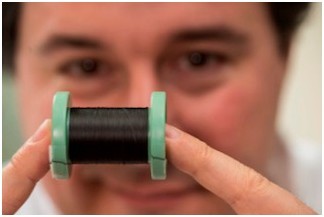Researchers from Rice University and Texas Heart Institute are investigating the application of soft, pliable carbon nanotube fibers to fix electrical gaps in heart tissues damaged by cardiac arrhythmias, which affect over 4 million people in America every year.

Rice scientist Matteo Pasquali holds a spool of fiber made of pure carbon nanotubes. The fibers are being studied to bridge gaps in the conductivity in damaged heart tissues. (Credit. Jeff Fitlow)
The research is supported by the American Heart Association.
In general, electrical signals control the beating of the heart by prompting the heart tissues to contract and relax. However, the presence of a scar in the heart tissue highly influences the electrical conductivity. Soft, highly conductive fibers prove effective to fix this problem.
“They are like extension cords,” said Mehdi Razavi, director of electrophysiology clinical research at the Texas Heart Institute and the projects lead investigator. “They allow us to pick up charge from one side of the scar and deliver it to the other side. Essentially, we are short-circuiting the short circuit.”
Developed in the lab of chemist and chemical engineer, Matteo Pasquali, at Rice, the nanotube fibers are measure around a quarter of the thickness of a human hair. However, millions of nanotubes (microscopic cylinders of pure carbon) have been identified in an inch-long piece of the material in the early 1990s.
According to Pasquali, the fibers were originally developed to replace the long cables in commercial airplanes and reduce weight, though gradually their potential in the medical sector became quite obvious.
“We did not design the fiber to be soft, but it turns out to be mechanically very similar to a suture,” he said. “And it has all the electrical function necessary for an application like this.”
When compared to the metal wires employed for transferring power to devices like pacemakers, the fibers are anticipated to be more favorable to biological applications due to their soft, flexible and extremely tough characteristics. These fibers have already proven to be useful for treating neurological conditions of people with Parkinsons disease through brain implants.
“People who progress to heart failure can have the formation of scar tissue over time,” said Mark McCauley, a cardiac electrophysiologist at the Texas Heart Institute. “There are a lot of different ways scarring can affect conduction in the heart. Recently we have been most interested in the development of scarring after heart attacks, but we believe this fiber may help us treat all kinds of cardiac arrhythmias and electrical-conduction issues.”
“Metal wires themselves can cause tissue to scar,” said Flavia Vitale, a research scientist in Pasqualis lab who is developing nanotube fiber applications. “If you think about inserting a needle into your skin, eventually your skin will react and completely isolate it, because it is stiff. Scar will form around the needle."
“But these fibers are unique,” she said. “They are smaller and more flexible than a human hair and so strong that they can resist flexural fatigue due to the constant beating of the heart.”
Vitale stated that because of the low impedance of the fibers, the electricity can be shifted from tissue to bridge and return back more efficiently compared to metal wires.
The researchers are investigating the biocompatibility of the fibers, with a hope that human trials are no more than a few years away.
Razavi noted that a safe, effective method of conducting electricity through scarred heart tissue will lead to a breakthrough in treating cardiac arrhythmias. “Should these more extensive studies confirm our initial findings, a paradigm shift in treatment of sudden cardiac death will be within reach, as for the first time the underlying cause for these events may be corrected on a permanent basis,” he said.
Pasquali said that he is pleased to see that the development of nanotechnology, the field in which Rice is renowned, could help save lives. “We have been excited from the beginning to learn about each others areas and come up with uses for the material,” he said of his friendship – and now collaboration – with Razavi. “We are determined to find ways to treat rather than manage disease.”

